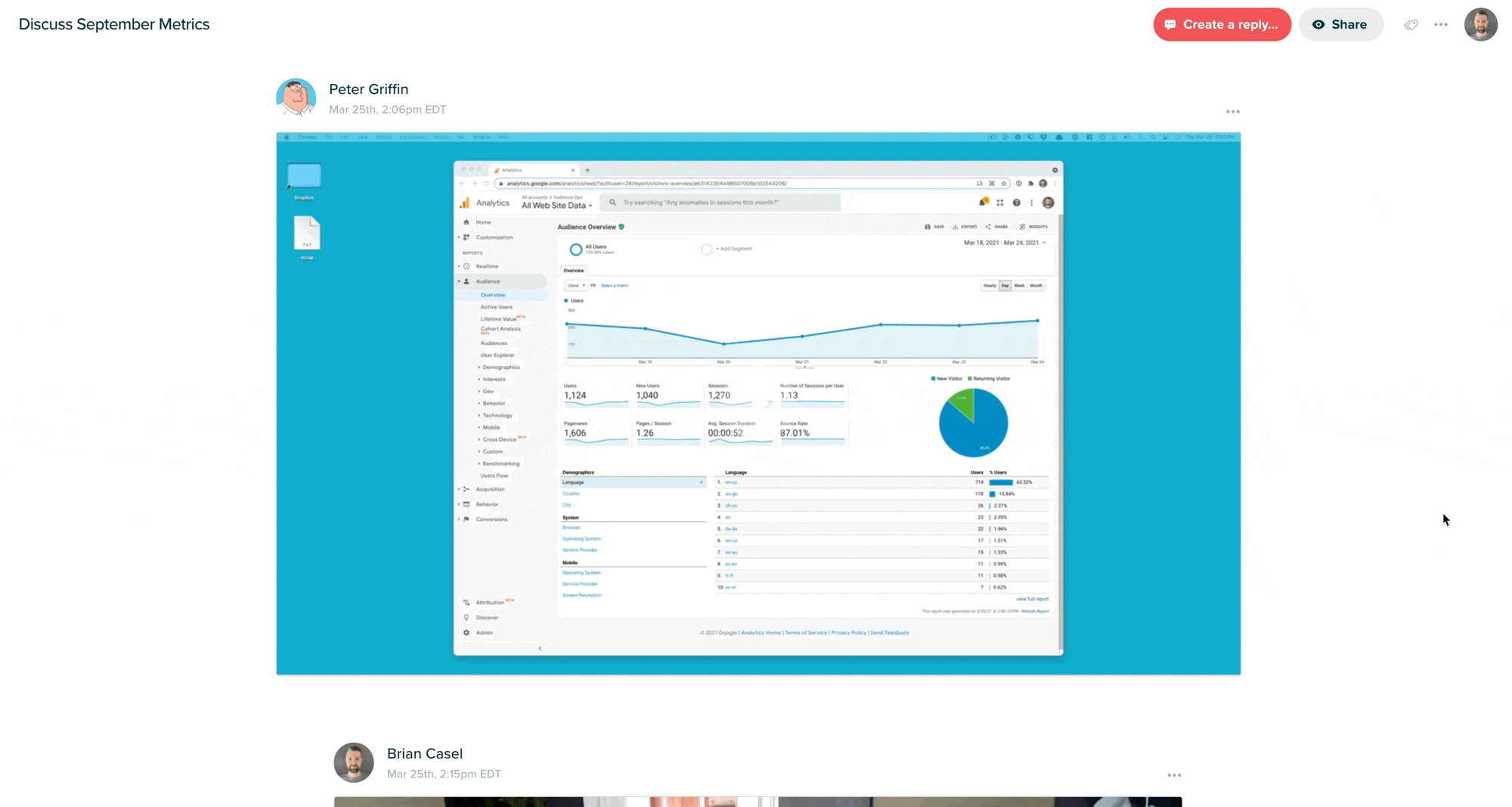How to scale client services using asynchronous communication
Whether you work as a freelance consultant or a manager in a digital agency, people are at the heart of what you do. Helping customers solve problems, grow their business and navigate new territories is part of the service you provide.
This requires clear, consistent and collaborative communication. (After all, they pay you a lot of money to get access to you.)
Unfortunately, since your customers appreciate your expertise and often want more contact time, your business probably takes a back seat. When you're busy with back-to-back Zoom calls and catching up on Slack, it's hard to grow your business or scale your services.
But it doesn't have to be like that.
Today I'm going to talk to you about a delightfully different approach to communicating with customers (that will save you both time!): asynchronous communication. I'll expand on the problem it solves, why it's an effective solution, and how to modify your client's workflow to take full advantage of it.
The problem: too many live calls (it's exhausting!)At first glance, having a calendar full of client meetings seems like a good problem to have. More calls means more business, and more business means more money in the bank. But a large volume of live calls every week also comes with significant downsides. Here are the main three:
Your mental health takes a nosediveHave you ever heard of meeting fatigue? Spending hours and hours in meetings and calls isn't just tiring; it's exhausting.
Zoom fatigue can disrupt your emotions and have a significant impact on your mood. Accordingly:
Your concentration drops. Your critical thinking and problem-solving skills take a hit. Your stress level skyrockets.And these side effects can also impact your communications with customers; when you feel tired and groggy, clarity can suffer.
You may not have the patience to explore solutions and provide proper explanations. You can overlook key facts and miss vital details. Your memory may suffer.This can be a great source of frustration for you and your customers.
Your physical health is deterioratingAs you know, spending too much time in front of your laptop (without proper breaks) is unhealthy. But the problem is, how do you make the time to take meaningful breaks with so many phone commitments? Sitting too long in the same position, such as at your desk while discussing branding with a client via Zoom, can lead to a wide range of health issues:
Back ache Muscle fatigue painful joints Dehydration Eye fatigue Headache Weight gain(To name a few)
Also, when your mental well-being suffers and your brain feels drained, it often shows in your appearance. If you're hoping to present a professional face to your clients and colleagues, the face of exhaustion staring at them through a screen isn't ideal.
Your business goals sufferIn addition to adverse health effects, too many calls can hurt your business in the long run. It's just not sustainable.
Think about what could happen if you drop the ball or start to underdeliver. If your clients decide to go elsewhere, they take not only their money with them, but also part of your professional reputation.
Plus, when you're short on hours in the day, it's impossible to focus on other areas of your business:
Research projects Participation in professional events Expand your area of expertise Creation of an online courseNot all of your lofty big business goals are achieved when you spend your energy working on other people's projects.
This brings us to the crucial question:
How can you provide your clients with consistent, high-quality, on-demand knowledge and advice without neglecting your health and your business?
The Solution: Scale Customer Services with Asynchronous CommunicationIn short, asynchronous communication involves discussions and conversations that do not happen in real time.
Sounds fancy, right?
Asynchronous communications have been around for a surprisingly long time. Our ancestors used cave paintings to communicate with each other and to attract the attention of all who passed by. People then responded in a similar artistic way, almost like old graffiti, but with more purpose.
Carrier pigeons, messengers on foot, telegram...

Whether you work as a freelance consultant or a manager in a digital agency, people are at the heart of what you do. Helping customers solve problems, grow their business and navigate new territories is part of the service you provide.
This requires clear, consistent and collaborative communication. (After all, they pay you a lot of money to get access to you.)
Unfortunately, since your customers appreciate your expertise and often want more contact time, your business probably takes a back seat. When you're busy with back-to-back Zoom calls and catching up on Slack, it's hard to grow your business or scale your services.
But it doesn't have to be like that.
Today I'm going to talk to you about a delightfully different approach to communicating with customers (that will save you both time!): asynchronous communication. I'll expand on the problem it solves, why it's an effective solution, and how to modify your client's workflow to take full advantage of it.
The problem: too many live calls (it's exhausting!)At first glance, having a calendar full of client meetings seems like a good problem to have. More calls means more business, and more business means more money in the bank. But a large volume of live calls every week also comes with significant downsides. Here are the main three:
Your mental health takes a nosediveHave you ever heard of meeting fatigue? Spending hours and hours in meetings and calls isn't just tiring; it's exhausting.
Zoom fatigue can disrupt your emotions and have a significant impact on your mood. Accordingly:
Your concentration drops. Your critical thinking and problem-solving skills take a hit. Your stress level skyrockets.And these side effects can also impact your communications with customers; when you feel tired and groggy, clarity can suffer.
You may not have the patience to explore solutions and provide proper explanations. You can overlook key facts and miss vital details. Your memory may suffer.This can be a great source of frustration for you and your customers.
Your physical health is deterioratingAs you know, spending too much time in front of your laptop (without proper breaks) is unhealthy. But the problem is, how do you make the time to take meaningful breaks with so many phone commitments? Sitting too long in the same position, such as at your desk while discussing branding with a client via Zoom, can lead to a wide range of health issues:
Back ache Muscle fatigue painful joints Dehydration Eye fatigue Headache Weight gain(To name a few)
Also, when your mental well-being suffers and your brain feels drained, it often shows in your appearance. If you're hoping to present a professional face to your clients and colleagues, the face of exhaustion staring at them through a screen isn't ideal.
Your business goals sufferIn addition to adverse health effects, too many calls can hurt your business in the long run. It's just not sustainable.
Think about what could happen if you drop the ball or start to underdeliver. If your clients decide to go elsewhere, they take not only their money with them, but also part of your professional reputation.
Plus, when you're short on hours in the day, it's impossible to focus on other areas of your business:
Research projects Participation in professional events Expand your area of expertise Creation of an online courseNot all of your lofty big business goals are achieved when you spend your energy working on other people's projects.
This brings us to the crucial question:
How can you provide your clients with consistent, high-quality, on-demand knowledge and advice without neglecting your health and your business?
The Solution: Scale Customer Services with Asynchronous CommunicationIn short, asynchronous communication involves discussions and conversations that do not happen in real time.
Sounds fancy, right?
Asynchronous communications have been around for a surprisingly long time. Our ancestors used cave paintings to communicate with each other and to attract the attention of all who passed by. People then responded in a similar artistic way, almost like old graffiti, but with more purpose.
Carrier pigeons, messengers on foot, telegram...
What's Your Reaction?






















